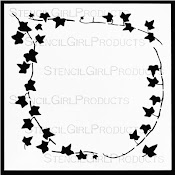Once more, I plead guilty to being disorganized enough to sometimes post artwork twice on this blog.
Hoping I'm not showing any repeats today, I'm lining up some stencil-prints made on assorted papers. I used a sponge brayer loaded with high-viscosity (heavy body) acrylic paint.
 |
| Above: Seaweed stencil (6" x 6") |




















































































